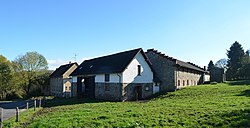Monastery throne

|
|
| location |
Germany Hessen |
| Coordinates: | 50 ° 17 '4.8 " N , 8 ° 34' 39.3" E |
| founding year | 1243 |
| Year of dissolution / annulment |
1576 |
| Mother monastery | Arnsburg Monastery |
The monastery (Marien-) throne ( thronus sanctae mariae ) was a Cistercian monastery near Wehrheim im Taunus .
founding
The monastery was founded on March 20, 1243 by Count Gerhard von Dietz . Gut Niedernhain formed the basis of the monastery . This was not an Allodium Gerhards, but an imperial fief , which did not prevent Gerhard from transferring it to the future monastery. The Counts of Dietz had reached the height of their power under the Hohenstaufen dynasty . In the context of the dispute between Emperor Frederick II and the Pope and the related ban on church , the imperial princes had gained the freedom to overlook the rights of the empire. In 1288 this mistake was cured by placing the monastery under the protection of the empire and releasing it from the sovereignty of the Dietzers.
Residents
The monastery was mainly inhabited by noble nuns convent . In its heyday in 1320, 60 nuns lived there. In 1527 there were still 17 nuns and 2 novices, in 1563 there was only one nun (the last abbess Margarete von Hattstein ) and 3 novices.
construction
In 1262, the Archbishop of Mainz, Werner von Eppstein , consecrated the monastery church. That was the end of the construction phase, which lasted from around 1244 to 1262. In 1249 the first abbess Irmgard and 12 nuns moved into the still unfinished monastery. The construction was financed from funds from the Niedernhain estate, from donations and the sale of letters of indulgence . Nine indulgences are known to finance the throne monastery. In 1251 the monastery was incorporated into the order. The superior monastery was the Arnsburg monastery .
capital
The monastery owned the area between today's Lochmühle and the Erlenbach and extended beyond today's B 456 . Due to the poor soils, agricultural use was rather difficult. There were also 600 acres of forest. In the course of time, the monastery acquired a large number of properties and tithe rights . The monastery held a total of 145 such rights in its economic heyday. These included farms in Oberhain , Petterweil and Vilbel , various mills and three city courts in Frankfurt am Main , Friedberg and Wetzlar .
Downfall
The monastery began to decline in the 15th century. Financial bottlenecks and, above all, the general decline in willingness to support monasteries led to a slow decline. With the Reformation , the Throne monastery came into conflict between Catholics and Protestants. In 1528 Landgrave Philipp von Hessen , who owned a quarter of the Wehrheim office , introduced the Lutheran faith. Count Wilhelm von Nassau gave him a free hand. From 1548 onwards it was no longer possible for the Thron monastery to find a Catholic priest. The abolition of the monastery or the enforcement of a conversion was Count Johann VI. from Nassau-Orange not possible, since Kurtrier had shares in the Wehrheim office since 1564. However, he prevented the admission of new nuns. The history of the monastery ended with the death of Magarete von Hattstein in 1576. The facility was subsequently continued as an agricultural property. Half of the Thron estate belonged to the Doctions Fund at Montabaur and the other half to the Fund of the Academie zu Herborn . With the establishment of the Nassau Central Study Fund (NSF) in 1817, ownership passed into its hands. The NSF is still the owner today. Werner Etzel is the current tenant of the estate with an area of 120 hectares.
Monument protection
The entire complex of today's courtyard and the former monastery mill are listed as a cultural monument .
swell
- Ulrich Simon : The Cistercian monastery Thron near Wehrheim im Taunus. State, religious, economic and social history studies . Historical commission for Nassau : Wiesbaden 1986. (= publications of the historical commission for Nassau, vol. 41). ISBN 3-922244-71-8 .
- Ulrich Simon: Article Throne . In: Friedhelm Jürgensmeier, Regina Elisabeth Schwerdtfeger (edit.): The monastic and nunnery monasteries of the Cistercians in Hesse and Thuringia , part 2. EOS-Verlag , St. Ottilien 2011. (= Germania Benedictina , ed. By the Bavarian Benedictine Academy , historical Section, Vol. IV-2). ISBN 978-3-8306-7450-4 . Pp. 1497-1521.
- Johanna Koppenhöfer: The history of the throne monastery in Wehrheim . In: Yearbook of the Hochtaunuskreis 1995 , ISSN 0943-2108 , pp. 207-217.
- Eva Rowedder: Hochtaunuskreis . Ed .: State Office for Monument Preservation Hessen (= monument topography Federal Republic of Germany , cultural monuments in Hessen ). Konrad Theiss Verlag, Darmstadt 2013, ISBN 978-3-8062-2905-9 , pp. 677-679 .